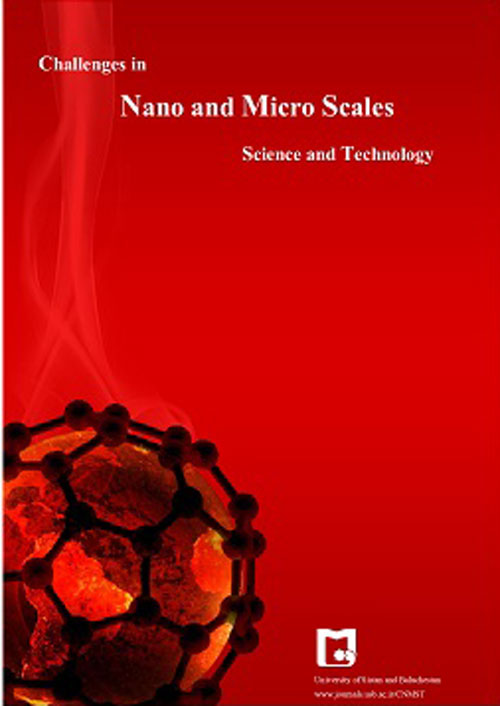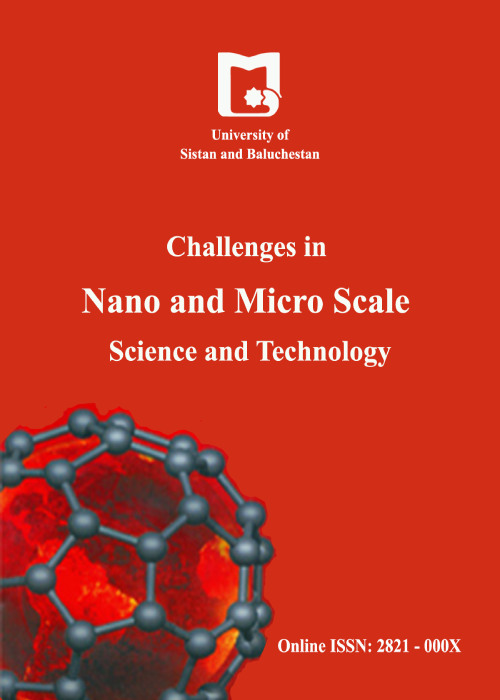فهرست مطالب

Journal of Transport Phenomena in Nano and Micro Scales
Volume:9 Issue: 1, Winter-Spring 2021
- تاریخ انتشار: 1401/01/16
- تعداد عناوین: 7
-
-
Pages 1-11In this work, the energy and exergy efficiencies of a nanofluid–based direct absorption solar collector (DASC) are examined experimentally. Attention is focused to analyze the consequences of installation of porous foam in the collector, concentration of the nanoparticles (NPs) in the working fluid, and volumetric flow rate of the nanofluid from the standpoints of the first law and second law of thermodynamics. The porous foam is made up of SiC while the nanofluid contains SiC NPs in water as the base fluid. The results indicate that the foam installation improves both efficiencies. The dominant parameter on the energy efficiency is recorded to be the volumetric flow rate of the nanofluid but the highest contribution on the exergy efficiency belongs to the NPs concentration in the working fluid. More precisely, maximum changes in the exergy efficiency due to the variation in the NPs concentration in the working fluid is recorded to be 63.2%. Meanwhile, it is found that the foam installation and the alternation of the volumetric flow rate of the nanofluid bring 38.2% and 25.3% variations in the exergy efficiency, respectively.Keywords: Direct absorption solar collector (DASC), Exergy analysis, Nanofluid, Porous foam
-
Pages 12-22In this study, the efficacy of magnetic field on the two-phase nanofluid flow in the flattened tube was numerically examined. Initially, the finite volume method was used to solve the flow field and temperature. Secondly, the two-phase flow model was utilized to simulate the nanofluid flow. The consequences are associated with previously published data and good agreement observed. Thirdly, the uniform magnetic field is presumed to be constant, non-uniform, and oscillating. The results indicate that heat transfer and pressure drop enhance with growing flatness and the nanofluid volume fraction. In the case of the constant magnetic field is exerted in the three directions, the Nusselt number increases by about 2.5 %. The 90 ° phase delay in the oscillating magnetic field improves the heat transfer coefficient by 2%. The non - uniform magnetic field of 0.5 Tesla rather than without magnetic field in volume fraction of 0.01- 0.05 the heat transfer coefficient increases in about 1.6 – 2 times rather than the first mode. In addition, the velocity and temperature profile approached the uniform manner.Keywords: heat transfer, non-uniform, oscillating magnetic field, Nanofluid, flattened tube
-
Pages 23-34The present paper aims to study the effects of different mass fractions of silica nanoparticles on the tensile, compressive, and flexural mechanical properties of polymer composites via experimental methods and non-linear damage model. Epoxy polymers consist of two parts: the first part has a low viscosity, ML-506, as the epoxy base, and the second part contains a polyamide as a hardener, HA-11. Spherical silica nanoparticles with four different mass fractions of 0, 0.2, 0.5 and 1 % are dispersed into the epoxy polymer system under two different ultrasonic times. The tensile and flexural mechanical properties of the prepared samples are determined using standard tests. Experimental measurements show that the mechanical properties of polymer composites improve with increasing mass fraction of nanoparticles. In addition, increasing the ultrasonic time from half-an-hour to one hour is further improves the mechanical properties of polymer composites. A non-linear damage model based on the Weibull theory is used to interpret the flexural stress–strain relationships of the tested materials. The parameters in this model are tensile modulus E, Weibull scale parameter σ0 and Weibull shape parameter β. A good agreement is seen between the results of the stress-strain curve obtained from the above mentioned model and experimental results.Keywords: Polymer, Composites, Stress, Strain relationship, Non-linear Damage Model, Scanning Electron Microscopy (SEM)
-
Pages 35-47In this paper, forced convection flow and heat transfer of Cu-water nanofluid in U-Tube collector are studied. The three-dimensional governing equations are numerically solved in the domain by the control volume approach based on the SIMPLE algorithm. Reynolds numbers are considered in laminar-turbulent range of 2000<Re<8000. The most efficient model was achieved by comparison of different parameters to reach the optimal case with the maximum exergy efficiency. From this study, it is concluded that in the case of using U-tube, instead of shell and tubes, the time that the fluid is inside the collector increases and leads to outlet temperature increase from the collector the exergy efficiency increases. Also, it is realized that enhance the outlet fluid temperature, energy efficiency and exergy efficiency. Generally, while the trend of exergy efficiency variation with effective parameters is increasing, applying the mixers precipitate the efficiency increment. In addition, for the case that the trend of exergy efficiency variation with changing these parameters is decreasing, the decreasing trend gets slow. The exergy efficiency of studied UTC at 14:00 has the maximum exergy efficiency among all studied times and about 71.54%. The received energy always reduces by increasing of operating temperature. The value of received energy at operating temperature of 23°C is about 0.347 kW/m2. The nanofluid flow has higher thermal conductivity than the base fluid and can absorb more solar irradiances. But the nanofluid has also more dynamic viscosity than base fluid which increases the pressure drop penalty and friction factor in system. Finally, the highest exergy efficiency was obtained for the nanoparticle volume fraction of ϕ=4%. Therefore, the UTC with tube diameter of 8nm filled with Cu-water nanofluid with 4% volume fraction and 40nm nanoparticle diameter at Re=2000 is introduced as the best model in present study.Keywords: U-Tube collector, Exergy efficiency, Radiation, Forced convection, Nanofluid
-
Pages 48-62
The separation of micron-sized particles and their sorting is a critical issue in diagnosing cancer and biological analyses. For fast and accurate separation and sorting of circulating tumor cells (CTCs), various methods have been presented so far. CTCs which are responsible for cancer metastasis have the potential to provide significant prognostic and diagnostic values. In this paper, some procedures for the separation of CTCs are studied which are generally based on passive methods. These methods use the interaction between particles, flow field, and channel structure. In this study, various designs in connection with passive methods for separating and sorting CTCs are discussed, including filter/deformation, Pinched Flow Fractionation (PFF), Deterministic Lateral Displacement (DLD), inertia and Dean flow fractionation, tunable microfluidic systems, Hybrid microfluidics, and Carpet microfluidic chip technology. Overall, a list of challenges for the micro-fluidic-based cancer cell separation technologies needs to be dealt with to make them more applicable, useful, and ultimately more mature, from lab-oriented researches to real-world applications. It is suggested to perform numerical simulations by considering real shapes of rare cells. Besides, the impact of cell deformability, non-Newtonian impacts, and stretchable channels should be assessed in numerical examinations.
Keywords: Cell separation, CTCs, Passive method, Microfluidics -
Pages 63-68
In this study, the Multi-Objective Optimization (MOO) of HIV virus separation from blood sample in a Lab on a Chip (LOC) is investigated using Computational Fluid Dynamics (CFD) and NSGA algorithm. The separation device consists of two horizontal microchannel separated by a porous layer. The flow is controlled by an infinitesimal channel section connected to one of the microchannels. First, using CFD approach, the fluid flow is studied in over 150 separation devices with different geometrical parameters. All performance parameters like separation efficiency and pressure drop are calculated. Then, already computed numerical results are targeted by multi-objective genetic algorithm (NSGA II). In optimization process, eight different geometrical and process parameters are considered as optimization variables. Maximum separation efficiency and minimum pressure drop caused by separation are considered as two conflicting optimization objectives. Pareto front is presented to assist design of the efficient separators. Optimization yielded the optimum configuration of the geometrical and process parameters for the highest efficiency and lowest pressure drop in HIV virus separation process.
Keywords: LOC, HIV, CFD, NSGA II, Multi-objective optimization -
Pages 69-80This paper examines experimentally the heat transfer of the internal convection of MgO-water nonofluids in a copper tube for a fully turbulent regime under constant heat flux boundary condition. The Nusselt number and convective heat transfer coefficients of nonofluids in different volumetric concentrations (0, 0.05%, and 0.15%) of nonofluids were estimated. Local convective heat transfer coefficient was also observed at different points along the pipe at different Reynolds numbers. The results showed a larger heat transfer coefficient with nonofluids compared to the base fluid. Heat transfer coefficient increased with an increase in the flow rate of nofluids from 6 to 10 l/min and the concentration of nonofluids from 0 to 0.15 vol.%. Conversely, the heat transfer coefficient decreases with increasing the nanofluid inlet temperature from 30 to 40 °C .Nusselt numbers increased to 45.9% as a result of the implementation of nonofluids at concentration of 0.15 vol.% in comparison with the base fluid. The Taguchi method was also used to analyze the results statistically. The maximum Nusselt number in nonofluids, the effect of each operational parameter on the Nusselt number, as well as the optimal values of each parameter was determined.Keywords: Design of experiment, heat transfer, Nanofluid, Nusselt number


